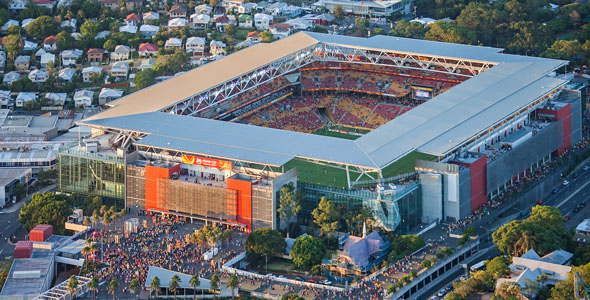The AFC Asian Cup Was One of the Most Talked About Football Events Ever in Asia. What Does this Greater Connectivity Mean for the Future of Stadium Design? – Populous
February 25, 2015
Image: Ethan Rohloff
By Populous’ Senior Principals Richard Breslin and Paul Henry
The recent AFC Asian Cup hosted by Australia in January this year was one of the most watched and talked about football event ever in Asia.
More people went to the Games than ever before, more people throughout Asia watched the matches on television and even more were connected on social media.
The official #AC2015 Twitter hashtag reach was 3.1 billion by the end of the tournament. My colleague Paul Henry was at both a Quarter Final in Brisbane and the Final in Sydney and considers what this connectivity means for stadium designers …..
Soaking up the atmosphere, amongst 50,000 people at the Brisbane Stadium at Lang Park during the quarter final of the AFC Asian Cup, it was fascinating to reflect that more than 20 million people were also watching that same match on television in China.
It was a good illustration of the true intersection between the live and remote audience during a major sporting match in today’s digitally connected world and the real global connectivity sporting events offer to a city. For designers, it was also an opportunity to reflect on the key part stadium design plays within that mix.
Attending the live event with 50,000 other fans IS undoubtedly a special and exhilarating experience. But the reality is that you can’t always be there, especially if you live half way around the globe in Beijing, Cape Town or New York.
Technology has made it possible to view or listen in by television, radio or via the Internet. Ever since the Internet became a part of the design of sporting arenas some 15 years ago, Populous has strived to better design venues to reach two types of audiences -the live audience in the stadium or arena and the remote audience watching the game at home.
Now Social Media is part of the mix and it has brought a greater level of engagement that is much more personalised. It’s about sharing “your” experiences with “your” friends, instantly, regardless of where you friends are around the world. Social media has, in fact, enhanced the experience of interacting with the game.
We are witnessing exponential growth in the way audiences behave on social media at both the live event and at home. What’s more the digital habits of a football fan at an AFC Asian Cup live game can be quite different to those of a tennis fan at the Australian Open, or a cricket fan at the MCG where the longer event means fans have more time to interact with their friends on social media.
In the case of the Asian Cup, the vast majority of these incredible levels of activity on social media platforms were the remote audiences around the world.
So what does this phenomenon of ever growing connectivity and exposure mean for stadium design moving forward? Do we need to adapt the stadium further and if so how?
How, for example, do we make stadium even more accessible to the international broadcaster at the event, so they can better tell the “away team” story and make the Game more relevant for the fans sitting back home in Beijing or Seoul, New York or Paris.
The truth is that stadium design matters just as much for the live audience at the match as the remote audience around the world. It all begins with atmosphere. The intensity that atmosphere creates is the key to a great stadium design and maximizing atmosphere is what designers constantly strive to better achieve.

